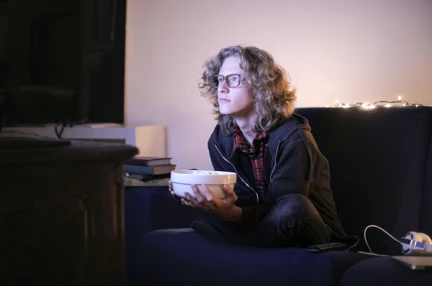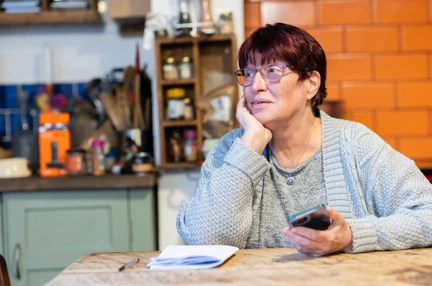Cooking with sight loss: Air fryers
Air fryers can have significant advantages for people with sight loss - not only simplifying meal preparation, but also greatly improving safety.
Read on to learn about the accessibility benefits of air fryers, the different options to consider and how to get started with yours.
Why use an air fryer?
Air fryers can support greater independence in the kitchen for people with sight loss. Here’s how:
With pre-set programmes, you can simply place your food inside, press a button and let the air fryer do the work with no monitoring.
The exterior of many air fryers stays relatively cool during operation, minimising the risk of burns - a key consideration for users with sight loss.
From roast chicken to hand-cooked chips, many dishes can be prepared in minutes, reducing the need to spend extended time at the stove.
Air fryers use hot air circulation to cook food, requiring little or no oil. This method offers a healthier alternative to deep frying.
Air fryers cook food faster than conventional ovens, often using less electricity, although they can only cope with smaller portions.
Most air fryers come with non-stick, dishwasher-safe baskets, making cleaning easier and more manageable.
Choosing an air fryer for low vision
Finding the right air fryer depends on your needs and preferences. While many models have similar features, there are important variations that could make it easier for you to use:
These models provide voice prompts rather than beeps. They guide you through cooking steps and alert you when the appliance is hot, improving both ease of use and safety.
Physical dials can be easier to operate than flat buttons or touchscreens. Tactile markers (such as bumpons) can be added to aid navigation and repeat use of common settings.
Some touchscreen models offer bright, high-contrast displays. Depending on your level of vision, this might offer a fast and intuitive interface if the text is large enough for you.
Some air fryers offer smartphone app control, which can be more accessible as you can operate them through screen readers and larger displays.
Automatic shut-off when the air fryer is no longer in use can be a definite benefit in improving safety for users with visual impairments.
Sight loss tips for using an air fryer
Using an air fryer is pretty easy, but like anything new it can take a bit of getting used to so don't be surprised if you need a bit of help at first. The following tips could get you started more quickly:
An air fryer takes up space, which can be tricky in a small kitchen. But for people with sight loss, moving it around could make it harder to use. So, if at all possible, find a good spot for it and leave it there.
Anything new takes time to get used to, particularly for people with sight loss. Practise using the buttons and familiarise yourself with the touchscreen and the basket before you start cooking.
Sticking tactile markers such as bumpons on frequently used buttons or settings to help with navigation can be a big help if you struggle to see the numbers.
Ask family or friends for a demo, or try a Smartphone support app like Be My Eyes. Blind Veterans UK beneficiaries should ask their community support worker to refer them to a rehabilitation officer.
"Blind Veterans UK staff taught me how to use my air fryer by putting bumpons on the settings. I can make anything in it now. My favourite's pizza - just eight minutes and its done. Simple as that!"
Getting the most out of your air fryer
While pre-set programmes mean no more monitoring cooking times, there are a few key practicalities to make sure your food is cooked well:
Preheating helps cook food evenly and improves crispiness - especially important for chips!
Place food in a single layer to allow hot air to circulate. Overfilling can lead to uneven cooking and soggy food.
Gently shaking the basket part-way through cooking ensures even browning and prevents sticking.
One of the key benefits of an air fryer is reducing cooking oil. Adding too much oil may create smoke and affect taste and texture.
The high heat and rapid air circulation can cause too much sauce to splatter, making a mess and potentially becoming a fire hazard.
Recipes to help you get started
Chips
Step 1: Peel the potatoes, then cut into finger-sized strips. Rinse well under cold water, drain then tip on to kitchen towel and pat dry.
Step 2: Tip into a bowl, drizzle over the oil and sprinkle over plenty of seasoning. Toss to combine.
Step 3: Preheat the air fryer to 180°C. Arrange the chips in the air fryer basket in a single layer. Cook for 30 minutes, turning halfway, until golden and crisp. Serve.
Lamb chops
Step 1: Preheat air fryer to 200°C. In a medium bowl, mix the oil, garlic and plenty of seasoning. Add the lamb chops and mix to coat.
Step 2: Add the lamb to the air fryer basket and cook for 6 minutes, turning over halfway. Serve.
Salmon fillets
Step 1: Add the salmon fillets to a bowl and message gently with your season and oil. Skin-on or skinless will both work.
Step 2: Place the salmon in the air fryer and air fry (typically takes 8-15 minutes, depending on the size)
Step 3: Open the basket and check for desired doneness with a fork. Serve.
Sweet potato crisps
Step 1: Preheat your air fryer to 200°C.
Step 2: Thinly slice a sweet potato and coat with olive oil, seasoning and dried thyme.
Step 3: Lay out in the air fryer basket and cook for 14 minutes, turning over halfway through. Serve.
For more information
If you're a Blind Veterans UK beneficiary, please speak to your community support worker. Otherwise, please call the RNIB helpline on 0303 123 999.
"Our rehabilitation officers can show Blind Veterans UK beneficiaries the most appropriate adaptations based on their visual needs."
Read more about sight loss
Sight loss-friendly holidays
15 Jul 2025
Accessible, supportive holidays designed with your needs in mind.

Watching TV with a vision impairment
5 Jan 2024
Many of us rely on our televisions for entertainment – and having sight loss doesn’t need to mean missing out.

How different eye conditions can affect your sight
21 Aug 2023
Understanding the different parts of the eye and how they can affect your vision.

Sign up for email updates
We would love to keep you updated about our activities, services and ways to support us.
You can change your contact preferences at any time by calling us on 0300 111 2233 or emailing us. See our privacy policy for more details.